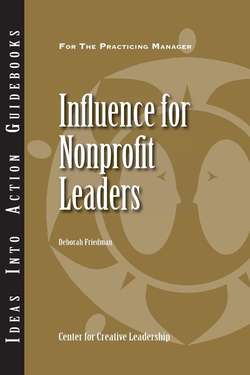Читать книгу Influence for Nonprofit Leaders - Deborah Friedman - Страница 8
На сайте Литреса книга снята с продажи.
ОглавлениеWhy Influence?
Influence is the power and ability to personally affect others’ actions, decisions, opinions, or thoughts. As such, influence is an essential component of leadership, allowing leaders to promote ideas and to inspire people. Influence is important because it helps leaders achieve desirable outcomes, such as communicating a vision, aligning the efforts of others, building commitment to the mission and work, and expanding an organization’s or a community’s capacity to meet its challenges. Many leaders have influence in their organizations, but they are not always sure how best to use it.
In nonprofit organizations, influence is particularly important. Relationships are vital to a nonprofit’s success. Leaders often use their influence to achieve results through staff members, volunteers, and other stakeholders. Nonprofit leaders don’t always have the same tools as leaders in corporate enterprises, such as the resources to grant promotions or to reward teams and individuals with bonuses. Nonprofit staff and volunteers often consider their work not just a job but a passion and a commitment. The influence a leader practices can keep people motivated. If volunteers and staff lose faith in the nonprofit’s mission and its leadership, they may not want to donate their time and energy to that cause and may seek opportunities elsewhere.
Influence in a nonprofit organization also helps to bring in and maintain funding to continue the nonprofit’s work. Nonprofits are often dependent on various sources for funding. Leaders in these circumstances can use influence to encourage continued funding from foundations, individual and organizational donors, government agencies, and other sources. Whether for staff, volunteers, funders, or the public in general, nonprofit leaders need well-developed influence skills that encourage those groups to support the nonprofit’s actions.
Nonprofit leaders who effectively influence others can achieve their goals and objectives more successfully than leaders who simply order people to do things. But what does it mean to effectively influence? To answer that question, you need to know that the use of influence skills or tactics can produce three distinctly different outcomes: resistance, compliance, and commitment. In Leadership in Organizations, Gary Yukl explains the differences between them.
Resistance
The least desirable outcome is resistance to the request you are making. People may directly oppose what you’re asking for or resist in less direct ways, perhaps sabotaging your efforts to influence. For example, they may initially agree with your request, but then put roadblocks in the way of its completion or make excuses about why it cannot be accomplished.
An organization is facing grim economic conditions on the horizon and extensive funding problems. The executive director decides to eliminate a department that, while once integral to the organization, has for some time brought diminishing returns and needs to be consolidated into another department to increase efficiency. The head of the department is a prized employee, and loyal members of the department resist the change, directly and indirectly sabotaging the executive director’s efforts. Other members of the organization publicly agree that the department needs to be cut, but privately express disdain for the executive director’s decision and are unwilling to cut and consolidate the department. In this situation, the executive director has been unable to influence members of this organization to carry out the request, and as a result has damaged some relationships and eroded trust.
Compliance
Compliance is better than resistance, and it is often the level of response you need to ensure that another person or group takes action in a desired way. Compliance is sufficient when your request is simple and routine and doesn’t require the other person or group to exert much additional energy, resources, or effort to accomplish it. You can settle for compliance in such situations because your request isn’t optional but required by the organization or by the team you lead.
A new hire in a local nonprofit is charged with enforcing compliance with governmental regulations, something her predecessor failed to do. However, her staff is at first hesitant and resistant to these regulations, claiming that they are unnecessary and pointless. The new leader uses her influence skills to convince the staff that, like it or not, they must follow regulations, and though the staff remains somewhat unconvinced, they comply with the leader’s request. This leader has used her influence to get compliance from her employees, which is all she needs to ensure that the organization adheres to regulations.
